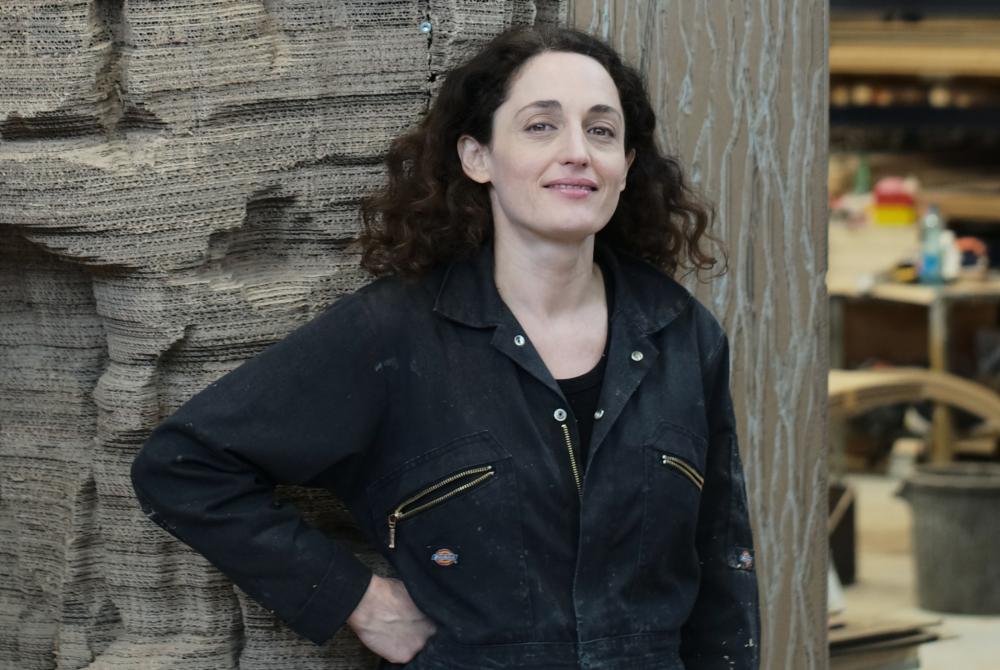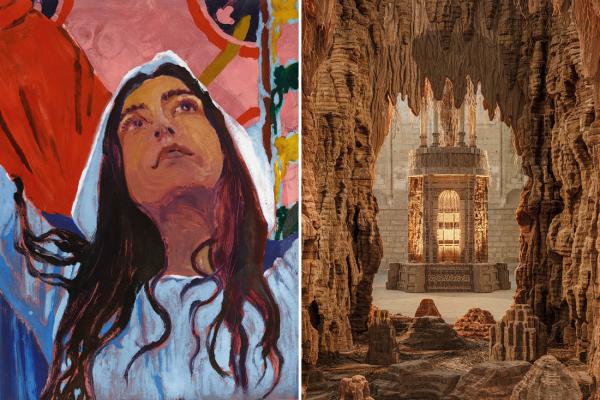Votre panier est vide
Besoin d'inspiration ?
Rendez-vous dans le programme en ligne du GrandPalais
Article -

This art is principally religious, but it was also expressed through civil and military buildings, which benefited from the technical innovations accompanying the emergence of the Gothic style. The systematic use of ribbed vaults and flying buttresses made it possible to erect very high buildings, the walls of which were now spanned by ample doors, galleries and arched windows. Light enters these buildings majestically, providing increasingly large canvasses for the art of stained glass and sculpture.
The first of the big Gothic cathedrals was built in Sens. The Saint-Denis basilica, constructed under the Carolingians’ reign and renovated between the 12th and 14th centuries, was then one of the major Gothic masterpieces. Its decorative style heralded certain sculptural techniques used in the big cathedrals of Reims, Chartres and the jewels of a future Gothic flamboyancy such as the Sainte-Chapelle in Paris and Strasbourg cathedral.
Ribbed vaults
The Gothic aesthetic originated with the invention of the ribbed vault. The Gothic ribbed vault is defined by the systematic use of arch bands and wall ribs, along with ribs. It was then perfected with the pointing of arches. The aureola of the pointed arch and the clusters of increasingly fine columns, rising to the vault's keystone, are characteristic of Gothic buildings. These very skilful constructions, which were intended above all to serve the glory of God and the grandeur of His church, give an impression of soaring straight up.
The first Gothic art
Combining ribbed vaults and the Romanesque tradition, the cathedrals of Angers (1149-1159) and Poitiers (1162) are examples of a primitive Gothic art, more austere and less well lit.
Originating in France, Gothic architecture then spread to the British Isles, notably in Canterbury cathedral, completed in 1185. It was also influential in the German Holy Roman Empire, where the Romano-Gothic style developed. This can particularly be seen in the cathedral of Limbourg-sur-Lahn which combines the round Roman arch and the Gothic ribbed vault.
And it was finally in France that the fundamental innovation in Gothic architecture appeared: in the nave of Notre Dame de Paris built between 1182 and 1225, for the first time the vaults were supported by a series of flying buttresses.
The Gothic heyday
Gothic art reached its heyday during the reign of Saint Louis (1226-1270). The reconstruction of Chartres cathedral powerfully demonstrated Gothic balance. The flying buttresses and ribbed vaults in a rectangular layout (wider than high) represent standard traditional Gothic architecture.
At the same time, as a result of the opening up of walls permitted by architectural innovations, frescoes were gradually replaced by stained glass. This flourished in the form of real works of stained glass art, or rose windows, the most famous examples of which are in Chartres cathedral. The Gothic tradition is also found in the sculpture of monuments. The two famous groups from Reims cathedral, the Annunciation and the Visitation (southern embrasure of the central door), are models which influenced all statuary in this period.
Influential and flamboyant Gothic
Over time, Gothic lines became finer, buildings higher and the stone lacework ever more complex. The dizzying conquest of vertical space ended suddenly with the collapse of the vaulted ceiling in Beauvais cathedral, which was due to reach 150m high.
In Paris, the most sumptuous example of this intensification of the Gothic style is the Sainte-Chapelle.
The dissemination of Gothic art
At the end of the 13th century, the Gothic style was adopted throughout Europe. It spread particularly to Saint-Urbain in Troyes and the nave of Saint Denis. The monumental style which appeared in sculpture under the reign of Saint Louis with the Sainte-Chapelle, would remain in vogue until the end of the 14th century. It can be found in the sculptures of the apostolic college of Saint-Jacques-de-l’Hôpital (1319-1327, Paris, Cluny Museum).
In Italy, Gothic art reached its heyday in the early 14th century. But already in painting and Florentine sculpture of the 14th century a desire to explore the representative space in a different way was emerging, with Simone Martini, and above all Giotto and the Pisano brothers. The inherited conventions of Byzantine icons were cast aside. As they had done in Antiquity, space and figures became three-dimensional, filling out. This sculptural research heralded the first signs of the Renaissance and its masterpieces by Masaccio and Piero della Francesca.
International Gothic art
Between the 14th and 15th centuries, at a time when some artists were already introducing Europe to the Renaissance, the prestige of Paris and the mobility of artists encouraged a broad dissemination of Gothic art, ensuring its rules were still adhered to. In the field of architecture, some religious buildings, such as Milan cathedral, resulted from international collaboration.
The flourishing of precious arts then reached an unprecedented scale. So much so that, in the collective imagination, some works from this period ended up intrinsically embodying the common perception of the Middle Ages: the illuminated Book of Hours, known as the Belles Heures of the Duke of Berry (1404-1410) by the Limbourg brothers, Charles V’s sceptre (Louvre Museum) and the tapestry of The Lady and the Unicorn (Cluny Museum). In around 1300, Parisian goldsmiths brought back into fashion cloisonné-enamel on gold, with the invention of plique-à-jour enamels (a term which refers both to the application and the complication). The Cluny Museum’s plates are a remarkable example of this. They may be the work of the most celebrated Parisian designer of plique enamels, Guillaume Julien, goldsmith to King Philip the Fair.
Despite this, the rediscovery of Antiquity, along with many other factors, very soon spelled the end of the Middle Ages. Synonymous with Barbarianism and seen as obsolete as a result of the new aesthetic treatises and the Italian taste, Gothic gradually disappeared to make way for the Renaissance.
Votre panier est vide
Besoin d'inspiration ?
Rendez-vous dans le programme en ligne du GrandPalais
See content : In the fantastic world of Eva Jospin: 8 questions for the artist

Article -
At the Grand Palais, Eva Jospin's "Grottesco" exhibition offers a timeless journey. Mysterious caves, sculpted nymphaea, petrified forests and "embroidered tableaux" come together to form a world apart. In this interview, the artist reveals her sources of inspiration, her relationship with cardboard and embroidery, and the way she turns each viewer into an explorer of her fantastical landscapes.
See content : Mickalene Thomas at the Grand Palais: an ode to love and black beauty!

Mickalene Thomas, Afro Goddess Looking Forward, 2015
Article -
It’s happening today! The exhibition All About Love opens its doors. With flamboyant portraits, self-assured bodies and bold expressions of femininity, Mickalene Thomas celebrates the beauty of Black women at the Grand Palais. A joyful and committed...
See content : It's open! Eva Jospin and Claire Tabouret: two new exhibitions at the Grand Palais

Article -
Until March 15, you're invited to explore the fascinating worlds of Eva Jospin and Claire Tabouret, presented in two Grand Palais galleries linked by the same entrance.